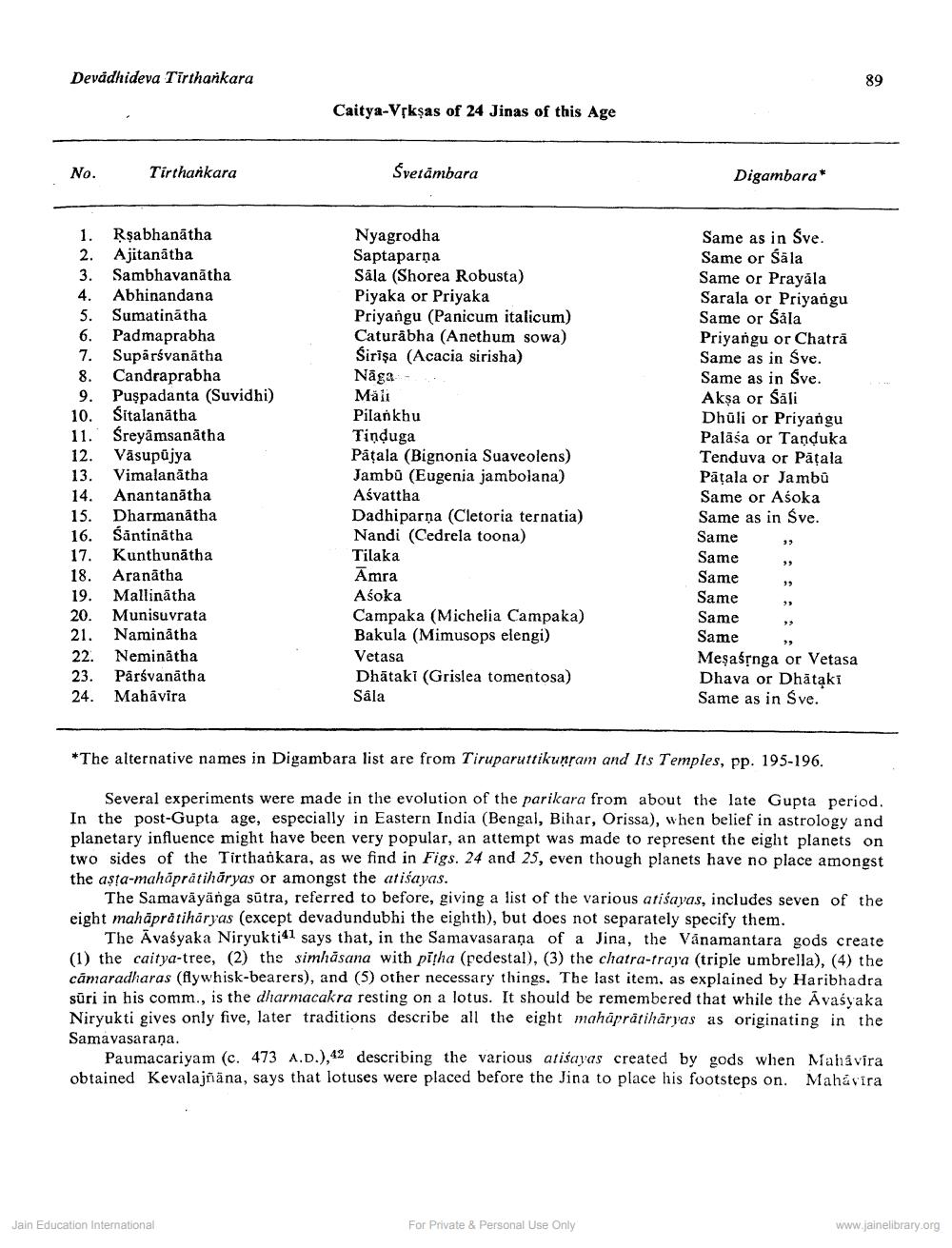________________
Devádhideva Tirtharkara
Caitya-Vkşas of 24 Jinas of this Age
No.
Tirtharikara
Svetambara
Digambara*
1. Rşabhanātha 2. Ajitanātha 3. Sambhavanātha 4. Abhinandana 5. Sumatinātha 6. Padmaprabha 7. Suparśvanātha 8. Candraprabha 9. Puspadanta (Suvidhi) 10. Sitalanātha 11. Sreyamsanatha 12. Vasupujya 13. Vimalanātha
Anantanātha
Dharmanātha 16. Santinātha 17. Kunthunatha 18. Aranātha 19. Mallinātha 20. Munisuvrata 21. Naminātha
Neminátha 23. Pārsvanātha 24. Mahavira
Nyagrodha Saptaparna Sāla (Shorea Robusta) Piyaka or Priyaka Priyangu (Panicum italicum) Caturäbha (Anethum sowa) Sirişa (Acacia sirisha) NāgaMaii Pilankhu Tinduga Patala (Bignonia Suaveolens) Jambu (Eugenia jambolana) Aśvattha Dadhiparņa (Cletoria ternatia) Nandi (Cedrela toona) Tilaka Amra Asoka Campaka (Michelia Campaka) Bakula (Mimusops elengi) Vetasa Dhātaki (Grislea tomentosa) Sala
Same as in Sve. Same or Sala Same or Prayāla Sarala or Priyangu Same or Sála Priyangu or Chatrā Same as in Sve. Same as in Sve. Akşa or Sali Dhüli or Priyangu Paläsa or Tanduka Tenduva or Patala Pāçala or Jambu Same or Asoka Same as in Sve. Same Same
14.
Same Same
Same Same Meşaśộnga or Vetasa Dhava or Dhātaki Same as in Sve.
*The alternative names in Digambara list are from Tiruparuttikunram and Its Temples, pp. 195-196.
Several experiments were made in the evolution of the parikara from about the late Gupta period. In the post-Gupta age, especially in Eastern India (Bengal, Bihar, Orissa), when belief in astrology and planetary influence might have been very popular, an attempt was made to represent the eight planets on two sides of the Tirthaikara, as we find in Figs. 24 and 25, even though planets have no place amongst the asta-mahāpråtihāryas or amongst the atisayas.
The Samaväyänga sūtra, referred to before, giving a list of the various atiśayas, includes seven of the eight mahăpråtiharyas (except devadundubhi the eighth), but does not separately specify them.
The Āvasyaka Niryukti41 says that, in the Samavasaraña of a Jina, the Vanamantara gods create (1) the caitya-tree, (2) the simhasana with picha (redestal), (3) the chatra-traya (triple umbrella), (4) the cámaradharas (flywhisk-bearers), and (5) other necessary things. The last item, as explained by Haribhadra sūri in his comm., is the dharmacakra resting on a lotus. It should be remembered that while the Āvašyaka Niryukti gives only five, later traditions describe all the eight mahärrätiharyas as originating in the Samavasarana.
Paumacariyam (c. 473 A.D.),42 describing the various arisayas created by gods when Mahavira obtained Kevalajñana, says that lotuses were placed before the Jina to place his footsteps on. Mahavira
Jain Education International
For Private & Personal Use Only
www.jainelibrary.org




